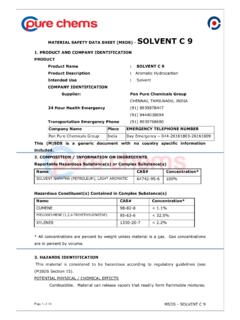Transcription of 2. HAZARD IDENTIFICATION - Global Partners
1 SAFETY DATA SHEET Diesel Fuel Page 1 of 11 June 2019 1. IDENTIFICATION Product Identifier Diesel Fuel Synonyms: Diesel Fuel, Motor Vehicle Diesel Fuel, Dyed Diesel, * DieselOne , * DieselOne w/Platinum Plus DFX, Low Sulfur Diesel (LSD), Ultra Low Sulfur Diesel (ULSD) Intended use of the product: Fuel Contact: Global Companies LLC Water Mill Center 800 South St. Waltham, MA 02454-9161 Contact Information: EMERGENCY TELEPHONE NUMBER (24 hrs): CHEMTREC (800) 424-9300 COMPANY CONTACT (business hours): 800-542-0778 2. HAZARD IDENTIFICATION According to OSHA 29 CFR HCS Classification of the Substance or Mixture Classification (GHS-US): Flam. Liquid Category 3 H226 Skin Corrosion/Irritation Category 2 H315 Aspiration HAZARD Category 1 H304 STOT SE Category 3 H336 Carcinogenicity Category 2 H350 Aquatic Chronic Category 2 H411 Serious Eye Damage/ Category 2B H319 Irritation Labeling Elements Signal Word (GHS-US): Danger HAZARD Statements (GHS-US): H226 Flammable liquid and vapor.
2 H315 Causes Skin irritation. H304 May be fatal if swallowed and enters airways. H336 May cause drowsiness or dizziness. H350 May cause cancer. H411 Toxic to aquatic life with long lasting effects. H319 May cause eye damage/irritation. Precautionary Statements (GHS-US): P210 - Keep away from heat/sparks/open flames/hot surfaces. - No smoking. P233 - Keep container tightly closed. P240 Ground/bond container and receiving equipment. SAFETY DATA SHEET Diesel Fuel Page 2 of 11 June 2019 P241 Use explosion-proof electrical/ventilating/lighting equipment pursuant to applicable electrical code. P242 Use only non-sparking tools. P243 Take precautionary measures against static discharge. P261 Avoid breathing dust/fume/gas/mist/vapors/spray. P264 Wash skin thoroughly after handling. P271 Use only outdoors or in a well-ventilated area.
3 P273 Avoid release to the environment. P280 - Wear protective gloves/ protective clothing/eye protection/face protection. P303+361+353 - If on skin (or hair): Take off immediately all contaminated clothing. Rinse with water/shower. P308+311 - If exposed or concerned: Get medical advice/attention. P301+310 - If swallowed: Immediately call a poison center/doctor/.. P331 - Do NOT induce vomiting. P370+P378 In case of fire use firefighting foam or other appropriate media for Class B fires to extinguish. P403+235 - Store in a well-ventilated place. Keep cool. P405 - Store locked up. P501 Dispose of contents/container in accordance with local/regional/national/international regulation. Other information: NFPA 704 Health: 1 Fire: 2 Reactivity: 0 3. COMPOSITION / INFORMATION ON INGREDIENTS Chemical Composition Information Mixture Name Product Identifier (CAS#) % (w/w) Classification Diesel Fuel 68476-34-6 100 Flam Liq.
4 3, H226; Skin Irrit. 2, H315; Aspiration 1, H304; STOT SE 3, H336; H350; Aquatic chronic 2, H411 Naphthalene 91-20-3 < Carc. 2, H351; Acute Tox. 4, H302; Aquatic Acute 1, H400; Aquatic Chronic 1, H410 Additional Formulation Information: Diesel Fuel consists of C9+ hydrocarbons resulting from distillation of crude oil. Low Sulfur Diesel Fuel typically contains less than 500 ppm of sulfur Ultra Low Sulfur Diesel Fuel typically contains less than 15 ppm of sulfur 4. FIRST AID MEASURES Route Measures Inhalation Remove person to fresh air. If person is not breathing, ensure an open airway and provide artificial respiration. If necessary, provide additional oxygen once breathing is restored if trained to do so. Seek medical attention immediately. SAFETY DATA SHEET Diesel Fuel Page 3 of 11 June 2019 Route Measures Ingestion Aspiration HAZARD : DO NOT INDUCE VOMITING.
5 Do not give liquids. Obtain immediate medical attention. If spontaneous vomiting occurs, lean victim forward to reduce the risk of aspiration. Ingestion may cause gastrointestinal disturbances including irritation, nausea, vomiting, and diarrhea, and central nervous system (brain) effects similar to alcohol intoxication. In severe cases, tremors, convulsions, loss of consciousness, coma, respiratory failure, and death. Eye Contact In case of contact with eyes, immediately flush with clean, low-pressure water for at least 15 min. Hold eyelids open to ensure adequate flushing. Seek medical attention. In case of contact lenses, remove immediately. Skin Contact Remove contaminated clothing and shoes. Wash contaminated areas thoroughly with soap and water or waterless hand cleanser. Obtain medical attention if irritation or redness develops. Thermal burns require immediate medical attention depending on the severity and of the area of the body burned.
6 Most Important Symptoms Contact with eyes and face may cause irritation. Long-term exposure may cause dermatitis (itching, irritation, pain and swelling). Inhalation may cause irritation and significant or long term exposure could cause respiratory insufficiency and pulmonary edema. Ingestion may cause aspiration, gastrointestinal disturbance, and CNS effects. Immediate Medical Attention and Special Treatment For contact with skin or eyes, immediately wash or flush contaminated eyes with gently flowing water. If possible, irrigate each eye continuously with saline (NS). If ingested, rinse mouth. Do NOT induce vomiting, as this may cause chemical pneumonia (fluid in the lungs). If inhaled, administer oxygen or establish a patent airway if breathing is labored. Suction if necessary. Monitor closely, anticipate seizures. Consider orotracheal or nostracheal intubation of airway control if patient is unconscious or is in severe respiratory distress.
7 Discard any clothing or shoes contaminated as they may be flammable. 5. FIRE-FIGHTING MEASURES Extinguishing Media Foam, carbon dioxide, dry chemical are most suitable SMALL FIRES: Any extinguisher suitable for Class B fires, dry chemical, C02, water spray, firefighting foam, or Halon. Small fires in the incipient (beginning) stage may typically be extinguished using handheld portable fire extinguishers and other firefighting equipment. LARGE FIRES: Foam, carbon dioxide, dry chemical. Water may be ineffective for fighting the fire, but may be used to cool fire-exposed containers. Specific Hazards / Products of Combustion Moderate fire HAZARD when exposed to heat or flame with a very low flash point. Product is flammable and easily ignited when exposed to heat, spark, open flame or other source of ignition. Flowing product may be ignited by self-generated static electricity.
8 When mixed with air and exposed to an ignition source, flammable vapors can burn in the open or explode in confined spaces. Being heavier than air, vapors may travel long distances to an ignition source and flash back. Runoff to sewer may cause fire or explosion HAZARD . Combustion may produce smoke, carbon monoxide and other products of incomplete combustion. Special Precautions and protective Equipment for Firefighters Isolate area around container involved in fire. Cool tanks, shells, and containers exposed to fire and excessive heat with water. For massive fires the use of unmanned hose holders or monitor nozzles may be advantageous to further minimize personnel exposure. Major fires may require withdrawal, allowing the tank to burn. Large storage tank fires typically require specially trained personnel and equipment to extinguish the fire, often including the need for properly applied firefighting foam.
9 SAFETY DATA SHEET Diesel Fuel Page 4 of 11 June 2019 Fighting Equipment/Instructions Firefighting activities that may result in potential exposure to high heat, smoke or toxic by-products of combustion should require NIOSH- approved pressure-demand self-contained breathing apparatus with full face piece and protective clothing. Refer to Section 9 for fire properties of this chemical including flash point, auto ignition temperature, and explosive limits. 6. ACCIDENTAL RELEASE MEASURES ACTIVATE FACILITY SPCC, SPILL CONTINGENCY or EMERGENCY PLAN. Personal Precautions Due to high vapor density, flammable / toxic vapors may be present in low lying areas, dikes, pits, drains, or trenches. Vapors may accumulate in low lying areas and reach ignitable concentrations. Ventilate the area. Use of non-sparking tools and intrinsically safe equipment is recommended.
10 Potential for flammable atmosphere should be monitored using a combustible gas indicator positioned downwind of the spill area. Refer to Sections 2 and 7 for further HAZARD warnings and handling instructions. Use appropriate personal protective equipment to prevent eye/skin contact and absorption. Use NIOSH approved respiratory protection, if warranted, to prevent exposures above permissible limits. Refer to Section 8. Contaminated clothing should not be near sources of ignition. Emergency Measures As an immediate precautionary measure, isolate spill or leak area for at least 50 meters (150 feet) in all directions. Consider wind direction. Secure all ignition sources (flame, spark, hot work, hot metal, etc.) from area. Evaluate the direction of product travel, diking sewers, etc. to confirm spill areas. Do not touch or walk-through spilled material.







